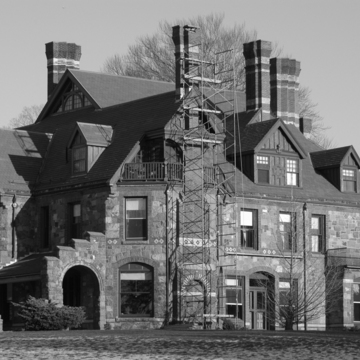The large country home William R. Emerson designed for William Ellery Channing Eustis in a semirural area of Milton was one of the largest and most important commissions of his career. Constructed of stone and brick, the house is polychromatic, but entirely unlike the then fashionable Venetian Gothic. The design is wholly original and conceived as a commanding presence on its hillside site. The distinctive stone displays combinations of gray, green, yellow, and red hues. Emerson chose predominantly red brick to match the massive red tile roof, but used yellow brick judiciously to accentuate ornamental details, as seen in the bands wrapping the tall ribbed chimneys. This combination of masonry makes such a strong visual statement that the wooden elements—principally the stickwork dormers and balustraded balconies—are minor features.
The interior of this extraordinary house remains, like the exterior, virtually unaltered from its 1878 construction. Obviously inspired by H. H. Richardson's Ames Gate Lodge (1884–1885) in North Easton, Massachusetts, in 1892 William Eustis, the owner, designed the fieldstone gatehouse along Canton Avenue, now a separate property.





















